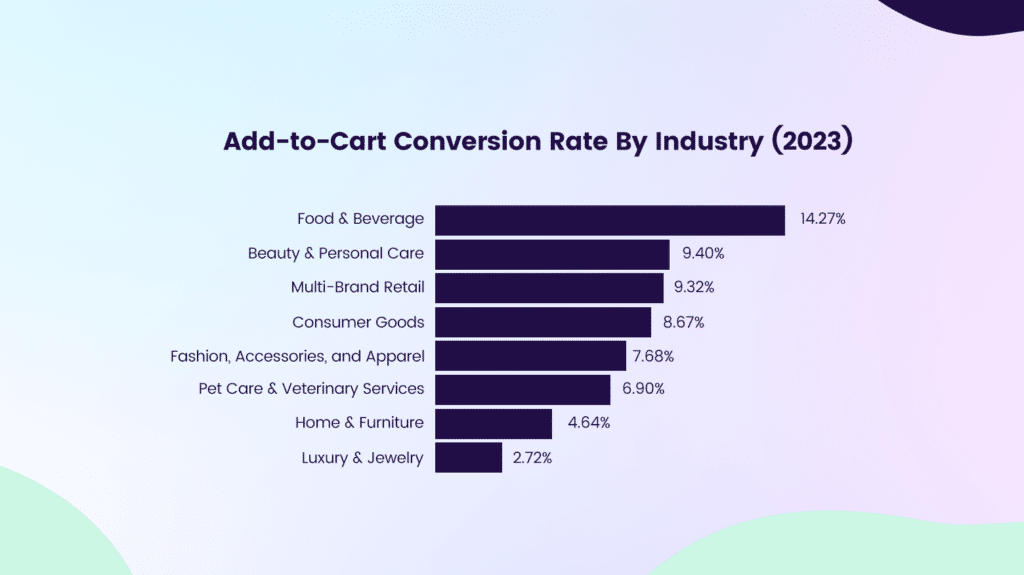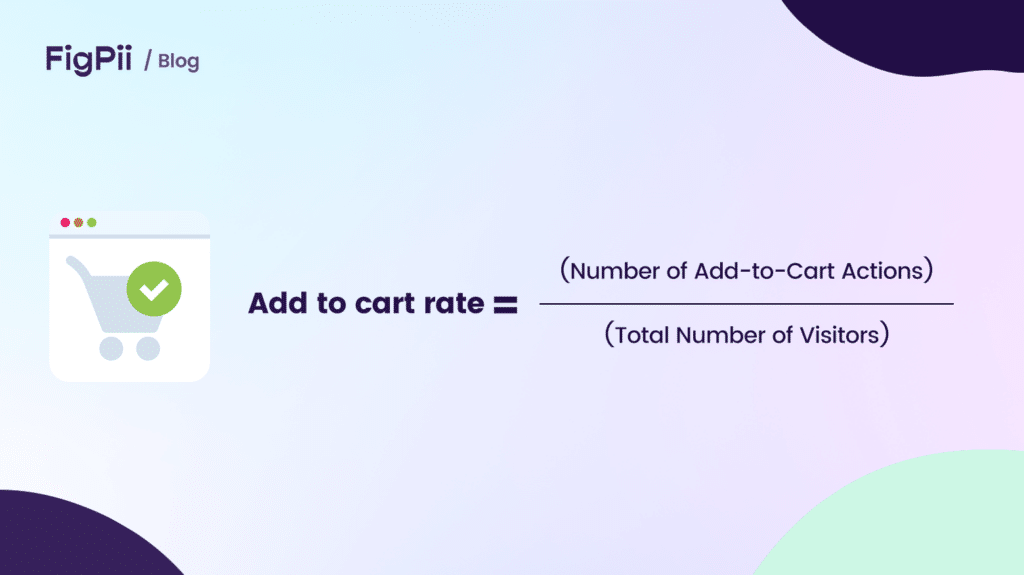In ecommerce, the success of an online store is closely tied to its ability to understand and effectively use various performance metrics. Among these is the ‘Add-to-cart rate,’ a key indicator of customer engagement and interest in products.
Unlike more general metrics such as page views or overall conversion rates, the Add-to-cart rate provides specific insights into how many visitors consider purchasing by adding items to their cart.
This metric is important because it serves as a precursor to sales. While final purchase numbers tell you about completed transactions, the Add-to-cart rate helps you gauge the initial interest level of your visitors.
What is Add-to-cart Rate
The Add-to-cart rate measures the percentage of visitors to a website who add at least one product to their shopping cart. It helps online retailers understand how effectively their site engages customers and encourages them to take the first step toward purchasing.
What sets the Add-to-cart rate apart from other ecommerce metrics is its focus on the early stages of the purchasing process. It’s about gauging the appeal of your products and the effectiveness of your site’s layout, design, and product placement in enticing potential customers.
For instance, imagine an online bookstore. If 1,000 people visit the store, and 100 add a book to their cart, the Add-to-cart rate would be 10%.
This rate helps the store understand how compelling their book selection and presentation are to visitors, which is a crucial step before any sales can happen.
Example to Illustrate the Concept
Consider an online clothing store. If 500 visitors browse the store in a day, and 100 of them add items to their cart, the Add-to-cart rate would be 20%.
This figure tells the store how effective their efforts are at moving customers from looking at products to taking the first step toward purchasing them.
In contrast, if the store measures its conversion rate and finds that only 20 of these 50 visitors make a purchase, the conversion rate would be 4% (20 out of 500).
This comparison helps the store understand different aspects of the customer journey – from showing initial interest to completing a purchase.
How to calculate Add-to-cart rate
The Add-to-cart rate formula is given by;
Add to cart rate = (Number of Add-to-Cart Actions) / (Total Number of Visitors)
This formula gives you the percentage of visitors who add at least one item to their cart. The ‘Number of Add-to-Cart Actions’ refers to how many times visitors added products to their cart, while the ‘Total Number of Visitors’ is the total number of unique visitors to your site.
For example, if your online store had 500 visitors in a day and 50 of them added items to their cart, your calculation would be:
Add-to-Cart Rate = (50/100) x 100 = 10%
This means 10% of your site’s visitors added items to their cart that day.
The Significance of Add-to-Cart Rate in Ecommerce
The add-to-cart rate’s significance extends beyond mere numbers; it directly impacts sales, reveals insights into customer behavior, and guides inventory and marketing strategies.
-
Impact on sales and revenue
A higher add-to-cart rate suggests that more visitors are considering purchases, which can increase sales.
This metric allows businesses to forecast sales more accurately and adjust their strategies accordingly.
For instance, a sudden drop in the Add-to-cart rate might signal a need to reevaluate product appeal or pricing strategies. At the same time, a consistent increase could indicate growing customer interest and potential for higher revenue.
-
Exploring its role in decoding customer behavior.
Understanding the Add-to-cart rate offers valuable insights into customer behavior. It helps e-commerce businesses identify which products or pages are most engaging and which need improvement.
By analyzing patterns in this rate, businesses can discern customer preferences, such as which promotions are most effective or what price points are most attractive.
This information is crucial for tailoring the online shopping experience to meet customer needs and preferences more effectively.
-
Its influence on inventory management and marketing strategies.
The Add-to-cart rate also plays a significant role in inventory management and marketing. High add-to-cart rates on specific products can guide inventory decisions, ensuring that popular items are adequately stocked.
Conversely, lower rates might indicate a need for promotional efforts or a reevaluation of stock levels. In terms of marketing, this metric can inform which products to feature in campaigns and how to adjust marketing messages to resonate more with potential customers.
It’s a tool for aligning marketing efforts with customer interest, making promotional activities more targeted and effective.
-
Enhancing Customer Experience Insights
The Add-to-cart rate is a valuable metric for gaining insights into the overall customer experience on an e-commerce site. When businesses analyze this rate in conjunction with other metrics like time spent on site or page views, they can get a clearer picture of how users interact with their site.
For example, a high Add-to-cart rate and a high bounce rate indicate that while products are appealing, there may be issues with the checkout process or overall site navigation.
This holistic view helps pinpoint areas for improvement in the customer journey, ultimately leading to a more satisfying shopping experience.
What is a good Add-to-cart rate?
A ‘good’ Add-to-cart rate can vary significantly across different industries and types of e-commerce stores. On average, a rate between 8% to 10% is generally considered healthy, but this can differ.
For example, luxury goods stores have a lower rate due to higher prices. Fast-moving consumer goods might naturally have a higher rate than high-value items like electronics or jewelry.
Other factors include website design, ease of navigation, and the effectiveness of product descriptions and images.
To determine what a good Add-to-cart rate is for your specific e-commerce business, it’s essential to consider your unique context. This means looking at your historical data, industry norms, and specific business goals.

A gradual increase in the Add-to-cart rate over time is a positive sign for a new business, while established businesses aim for higher, more stable rates.
Understanding your customer base, market trends, and the specific nature of your products will help set realistic and relevant benchmarks for your Add-to-cart rate.
How to improve add-to-cart rate
Improving the add-to-cart rate is necessary to boost your e-commerce store’s performance. We’ll explore practical strategies to enhance this crucial metric, ensuring your website attracts visitors and successfully nudges them toward purchasing.
-
Optimize Product Pages.
Ensure that each product page is informative, visually appealing, and user-friendly. High-quality product images, detailed descriptions, transparent pricing, and easy navigation are essential. Consider including customer reviews and ratings to add credibility.
Beyond the basics, consider integrating interactive elements like 360-degree views or video demonstrations of products.
Remember, the goal is to provide enough information and visual appeal to make the decision to add-to-cart as easy as possible for the customer.
-
Offer Free Shipping.
Free shipping can significantly increase the likelihood of visitors adding items to their carts. Highlight this offer prominently on your site to encourage more add-to-cart actions.
To make this strategy even more effective, set a minimum purchase amount for free shipping to increase the average order value.
This approach not only encourages more add-to-cart actions but can also boost overall sales. Communicate this offer on product pages and during the checkout process to maximize its impact.
-
Send Abandoned Cart Messages.
Implement an automated system to send reminders to customers who have left items in their cart. Personalized messages or offering a small discount can encourage them to complete the purchase.
Personalize these messages based on the user’s browsing history and cart contents. Experiment with different timings for sending these messages – some users may respond to an immediate reminder, while others might need a nudge after a day or two. The key is to balance being helpful and not overly intrusive.
-
Use Exit-Intent Pop-Ups.
When a visitor shows signs of leaving your site, display an exit-intent pop-up. This can be a discount offer, a reminder of items in their cart, or a prompt to sign up for your newsletter.
These pop-ups can also gather feedback on why visitors leave without adding items to their carts. This information can be invaluable for further optimizing your site.
Be creative with your pop-up design and messaging to capture attention without disrupting the user experience.
-
Leverage Customer Feedback and Reviews.
Displaying customer feedback and reviews on product pages can build trust and influence buying decisions. Positive reviews can significantly increase the likelihood of add-to-cart actions.
Encourage your customers to leave reviews by sending follow-up emails after a purchase. Make it easy for them to submit reviews and consider offering incentives.
Showcasing a variety of reviews, including those that offer constructive criticism, can enhance authenticity and trustworthiness.
-
Personalized Marketing.
Use customer data to provide personalized recommendations. Showing visitors products that align with their interests based on browsing history can increase engagement and add-to-cart rates.
Utilize email marketing campaigns and retargeting ads to remind customers of products they viewed or added to their cart.
Personalization should extend to these campaigns, with content tailored to individual customer preferences and behaviors, making each communication feel relevant and personal.
-
Streamline the Navigation Process.
A clear and intuitive navigation structure helps visitors find products more quickly, increasing their chances of adding items to their cart. Ensure your search function is effective, and categorization is logical.
Regularly review your site’s analytics to understand how visitors navigate your store. Look for patterns in how they move through your site and identify any common drop-off points.
This data can guide adjustments in your site layout and navigation to make the shopping experience more intuitive.
-
Highlight Special Offers and Discounts.
Use banners or dedicated sections on your site to highlight special offers and discounts. These can act as strong incentives for visitors to add products to their carts.
Time-limited offers or flash sales can create a sense of urgency, prompting quicker add-to-cart actions. Be strategic about when and how you promote these offers, aligning them with customer shopping patterns or seasonal trends to maximize their effectiveness.
-
Improve Website Performance.
A fast-loading, responsive website provides a better user experience, encouraging visitors to spend more time on your site and explore products, which can lead to increased add-to-cart rates.
Regularly test your website’s performance across different devices and browsers. Pay attention to image sizes, caching strategies, and other technical aspects that can affect load times.
A seamless experience across mobile and desktop is crucial, as more consumers use multiple devices to shop online.
-
Conduct Regular A/B Testing.
Regularly test different elements of your website, such as product page layouts, call-to-action buttons, and images. This helps identify what works best for your audience and can lead to improved add-to-cart rates.
When conducting A/B tests, focus on one element at a time to clearly understand its impact. Test variations of your call-to-action texts, colors, and placements.
Analyze the A/b test results to gain insights into customer preferences and behaviors, and use these learnings to refine the user experience continuously.
Conclusion
The Add-to-cart rate is a critical metric in e-commerce, reflecting customer engagement and purchase intentions. To enhance this rate, focus on strategies like optimizing product pages, offering incentives like free shipping, and utilizing customer feedback.
It’s important to remember that e-commerce is an ever-evolving field, and what works today might need adjustment tomorrow. Continuous monitoring and improvement of your strategies are essential.
Keep an eye on your Add-to-cart rate and other key metrics, and be ready to adapt to changing consumer behaviors and market trends.
Add-to-cart Rate Frequently Asked Questions
How Can Google Analytics Help Improve Add-to-Cart Rates?
Google Analytics provides valuable insights into user behavior on your ecommerce site, such as which products are viewed most, how long visitors stay on product pages, and at what point they abandon their carts. This data can help identify areas for improvement to enhance the Add-to-cart rate.
What Role Do Product Reviews Play in Add-to-Cart Rate?
Product reviews significantly influence the Add-to-cart rate. Positive reviews build trust and credibility, making potential customers more likely to add items to their cart. Including customer reviews on product pages can be a powerful tool to increase the Add-to-cart rate.
What is Shopping Cart Conversion Rate?
The shopping cart conversion rate is the percentage of website visitors who add items to their shopping carts and proceed to complete the purchase. It’s calculated by dividing the number of completed purchases by the number of add-to-cart actions during a specific period.
What is Shopping Cart Advertising?
Shopping cart advertising refers to promoting products or services within the online shopping cart or checkout pages of an ecommerce store. This can include targeted product recommendations, offer banners, or ads for complementary products.
What Factors Influence Shopping Cart Advertising Cost?
The cost of shopping cart advertising varies depending on factors like the ecommerce platform, the complexity of the advertising campaign, and the targeted audience. Customization, advanced targeting options, and higher traffic volumes typically increase the cost.



